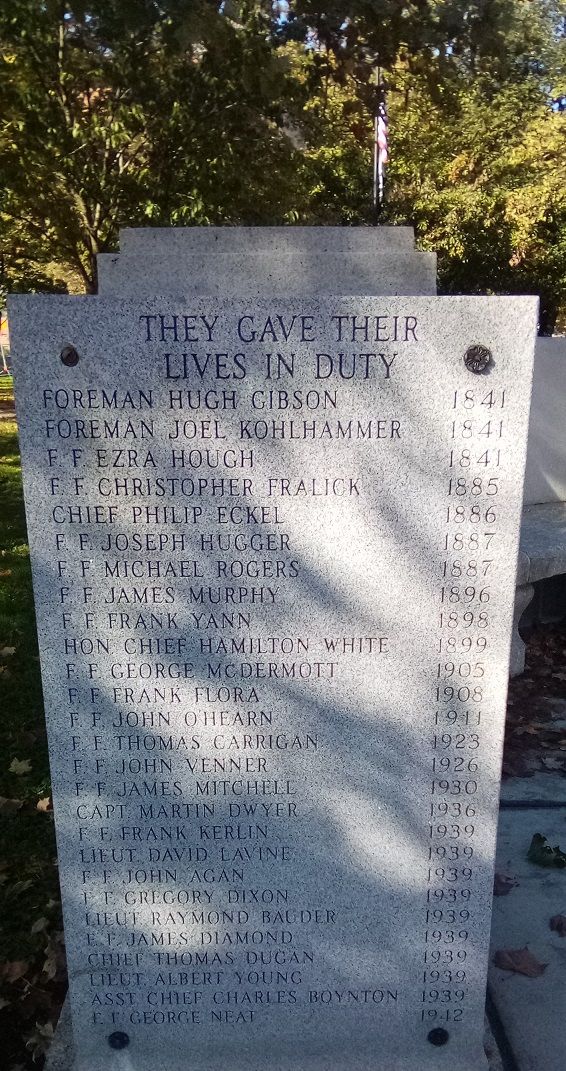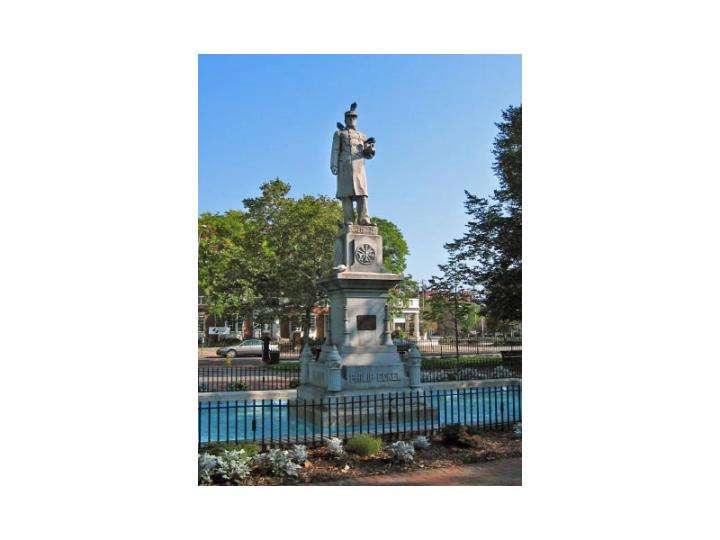After the war he served as Captain of the No. 2 volunteer fire company of Syracuse (again, made up mostly of Germans). He was later made Syracuse Fire Chief.
On 1 June 1886, Eckel sat on the side of Central City Hook and Ladder No. 1 as it responded to a fire on East Washington St. As the horse-drawn fire engine approached the New York Central railroad tracks, the driver noticed a freight train approaching on the track. The engine driver lashed the horses into a full gallop to clear the railroad tracks. The fire engine hit the tracks and Eckel either jumped or was thrown from the vehicle that ran over him. Eckel was still conscious and bystanders carried him into a nearby barbershop and summoned a doctor. From there, Eckel was transported by ambulance to his home where he later died from his injuries. A few days later Eckel's body was laid to rest in Woodlawn Cemetery. Thousands of mourners lined the route the funeral procession took to the cemetery. Over 1,000 firemen comprised the cortege. The Board of Fire Commissioners adopted a set of resolutions honoring the late Chief Engineer Philip Eckel.
A monument dedicated to Phillip Eckel was designed by the Carrick Brothers, a Vermont-based firm that opened a branch office in Syracuse in the 1890's. Carved from granite in Vermont, this memorial was funded by contributions raised by Syracuse firefighters and policemen.
Old photos show this monument in a number of different locations. At its August 22, 1900 dedication it was installed at the corner of North Salina, Butternut, and State Streets, in the midst of Syracuse's north side German community. Later (circa 1959) it was moved to the intersection of North Salina and Pearl Streets. Construction of Interstate 81 forced its final move downtown. The monument was moved to its present location in Fayette Park at the same time the park was renamed Fayette Firefighters Memorial Park, on May 2, 1979. Fayette Firefighters Memorial Park also contains the 1905 Hamilton White Monument, the Collins Block Fireman's Memorial, dedicated in 1939, a bell tower and a restored antique cast-iron fence. The park, a public green area since 1839, can be found bordered by North Townsend, East Fayette, North State and East Genesee Streets in the heart of the city.
After the war he served as Captain of the No. 2 volunteer fire company of Syracuse (again, made up mostly of Germans). He was later made Syracuse Fire Chief.
On 1 June 1886, Eckel sat on the side of Central City Hook and Ladder No. 1 as it responded to a fire on East Washington St. As the horse-drawn fire engine approached the New York Central railroad tracks, the driver noticed a freight train approaching on the track. The engine driver lashed the horses into a full gallop to clear the railroad tracks. The fire engine hit the tracks and Eckel either jumped or was thrown from the vehicle that ran over him. Eckel was still conscious and bystanders carried him into a nearby barbershop and summoned a doctor. From there, Eckel was transported by ambulance to his home where he later died from his injuries. A few days later Eckel's body was laid to rest in Woodlawn Cemetery. Thousands of mourners lined the route the funeral procession took to the cemetery. Over 1,000 firemen comprised the cortege. The Board of Fire Commissioners adopted a set of resolutions honoring the late Chief Engineer Philip Eckel.
A monument dedicated to Phillip Eckel was designed by the Carrick Brothers, a Vermont-based firm that opened a branch office in Syracuse in the 1890's. Carved from granite in Vermont, this memorial was funded by contributions raised by Syracuse firefighters and policemen.
Old photos show this monument in a number of different locations. At its August 22, 1900 dedication it was installed at the corner of North Salina, Butternut, and State Streets, in the midst of Syracuse's north side German community. Later (circa 1959) it was moved to the intersection of North Salina and Pearl Streets. Construction of Interstate 81 forced its final move downtown. The monument was moved to its present location in Fayette Park at the same time the park was renamed Fayette Firefighters Memorial Park, on May 2, 1979. Fayette Firefighters Memorial Park also contains the 1905 Hamilton White Monument, the Collins Block Fireman's Memorial, dedicated in 1939, a bell tower and a restored antique cast-iron fence. The park, a public green area since 1839, can be found bordered by North Townsend, East Fayette, North State and East Genesee Streets in the heart of the city.
Family Members
Advertisement
Explore more
Sponsored by Ancestry
Advertisement












